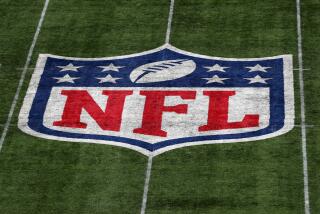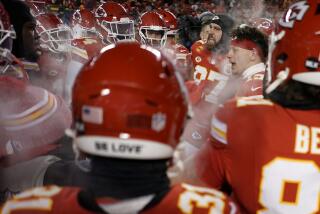PRO FOOTBALL THE SUPER BOWL : If Isn’t the Ultimate, Why Are We Hooked?
- Share via
TAMPA, Fla. — Lamar Hunt does not remember the exact time or place, only the circumstances. The year was 1966, and the owner of the Kansas City Chiefs was serving on a six-man committee to begin the process of merging the upstart American Football League with the established National Football League.
“We were talking about playing a championship game that season,” Hunt recalled the other day, “and in our conversations, we were debating one day whether to have two weeks off before the game. I was making a reference to the championship game, and I guess I said something like, ‘You know, the Super Bowl.’ Just said it. It came from one of my children. She’d been playing with something called a ‘Super Ball’ that took all these crazy bounces. Maybe that’s what I was thinking about. I just blurted it out, I guess.
“Well, the people around the room had these silly little smiles on their faces, and before long we all started describing it as the Super Bowl. I think if we had consciously tried to figure out a name for the game, we’d still be trying. Honest, it was a total accident.”
A quarter-century later, it is a national institution, watched by more than 150 million Americans on television and an estimated 750 million viewers worldwide. During the six hours of programming from pregame show to final gun, the country takes a collective deep breath. Highways are empty, crime in the streets virtually ceases, department-store clerks actually smile and elephants at the zoo go into peanut panic.
Yet it was not always so. The first game, between the Green Bay Packers and Hunt’s Chiefs, drew only 63,000 to the Los Angeles Coliseum, with television cameras panning occasionally on 32,000 empty seats. That first game was the only one not to sell out. And the only one broadcast by two sets of network announcers, since CBS carried the NFL and NBC the AFL.
The commissioner of the NFL, Pete Rozelle, was not particularly enamored with the name. He thought it was hokey and a bit presumptuous. He called the first meeting the “AFL-NFL World Championship Game.” Super Bowl did not appear on the cover of the game program until No. 3 in 1969 or on the ticket until No. 4 in 1970, the last game before the merger was complete.
The public, and particularly the media, had no such problems. Writers almost immediately picked up on Hunt’s creation, labeling the day Super Sunday, even if the first two games were Packers routs over the Chiefs (35-10) and Oakland Raiders (33-14).
Rozelle and many football people had other concerns before the first game. “There was some fear of the unknown,” said Hunt. “AFL and NFL teams had never even scrimmaged and some people thought we’d get killed. We held our own in that first one, but we definitely knew going in we weren’t as good as the Packers. And we weren’t.”
Green Bay coach Vince Lombardi felt pressure too. He did not want the established league embarrassed by the new kids on the block and the week before the game he told his team: “Nobody is going to leave that stadium until the job is done. I’ll keep you all day, all night, all week if necessary, until you win. There is no way the Green Bay Packers are going to lose this football game.”
A few weeks after the first game, Lombardi walked into a meeting of NFL owners and got a standing ovation for preserving the NFL’s honor.
Historians point to Super Bowl Three (Roman numerals did not appear until V), Jets vs. Colts, as the turning point. New York was an 18-point underdog, yet at a dinner a few nights before the game its brash young quarterback, Joe Namath, “guaranteed” a victory. When he and the Jets had upset Baltimore, 16-7, “there was no question that was a turning point in the public’s perception of this game,” said Don Weiss, then a public-relations aide to Rozelle and now the NFL’s director of planning.
But Weiss believes Kansas City’s defeat of the heavily favored Minnesota Vikings the following year may have been just as significant. The game was played at ancient Tulane Stadium in New Orleans, a few months after men had walked on the moon for the first time.
“When we found out the television ratings for that football game had surpassed the walk on the moon, we figured we had something there,” Weiss said. “I can still remember how startled Pete was when he found out that game was the most-watched television show of all time. That, to me, was the first visible sign that the Super Bowl was here to stay.”
That game was the final Super Bowl before the full merger went into effect and gave the old AFL a 2-2 record against the NFL.
“The happiest person I ever saw was Chet Simmons, the president of NBC Sports,” Weiss said. “NBC had the AFL TV contract and he was just beside himself. I remember after the game he went over to Jimmy Cannon (the influential New York sports columnist who had not been a great fan of the merger) and said to him, ‘So, what do you think now?’ ”
“People could write off the Namath game as a fluke,” added Jim Kensil, one of Rozelle’s most trusted executives then, now the retired president of the Jets. “Here you had the Vikings who were expected to dominate getting beat by what turned out to be a great Kansas City team. Now it’s all even as we merge, and people are starting to believe that these AFL teams can compete at the same level.”
There were other significant factors over the years that have seen ratings and audiences soar, advertising rates go from $85,000 a minute for the first game to $850,000 for 30 seconds this Sunday, ticket prices rising from $6-$12 for Kansas City-Green Bay to $150 each for New York Giants-Buffalo Bills here in Tampa Stadium.
Ticket distribution was critical. The first few games, the league tried to sell most of the tickets to fans in the host city, resulting in neutral crowds that muted the atmosphere. Gradually, allotments to the participating teams were increased, to the point where each team now gets 20 percent of the tickets and the host city only 10 percent, with the rest spread among the 26 other teams.
“That’s made it a tougher ticket,” Weiss said, “and also led to more of a party atmosphere around the game. You had a lot of fans from both teams coming into town and that really helped.”
So did expanded media coverage. The league issued 338 credentials for the first Super Bowl; this year, 2,500 were issued. And, of course, whichever network carried the game promoted it shamelessly on its regular programming, leading to a staggering statistic: Eight of the top-rated 15 shows in the history of television are Super Bowls, led by No. XVI in 1982 between San Francisco and Cincinnati.
Rozelle was not the only one to notice the eye-popping ratings over the early years. Corporate America quickly caught on, using the game to entertain its most-valued clients and buying up prime commercial time to hawk its products. On Sunday, there will be 35 corporate tents around Tampa Stadium entertaining more than 20,000 fans before they wander up to their seats.
On television, there was a cola war; a huge beer promotion known as Bud Bowl 3; the unveiling of new lines of sneakers in the 28 minutes of commercials that are expected to net ABC $45 million in revenue.
And, of course, the players and the games they played had just a little something to do with the popularity of the Super Bowl.
There was great interest in the 1972 Miami Dolphins, the first team to go undefeated (17-0) after beating the Washington Redskins, 14-7, in Super Bowl VII. The emergence of the Dallas Cowboys as America’s Team led by almost everyone’s favorite quarterback, Roger Staubach, in the mid-1970s and the dominance of the Pittsburgh Steelers at the end of the decade provided more impetus, as did memorable teams like the Redskins, Bears, Giants and 49ers in the 1980s.
So many heroes, so many heroic moments--Zonk up the middle; Swann soaring in space; Biletnikoff to the post; Montana driving downfield in the final seconds; Riggo around end to glory; Williams and 35 points in the second quarter.
And now, at its silver anniversary game, some people around the NFL wonder how they can top the first 25 years. A few weeks hence, a committee will gather to study that very question. The game now costs between $4 million and $6 million to stage, including an annual million-dollar party for 4,000 canceled this year because of war. And every year, the game with its ancillary events grows by 10 to 20 percent. Bigger pregame and halftime shows, commissioner’s party, corporate tent area, more media requests, more rooms to accommodate more fans, and on and on.
“We’re going to talk about how you keep topping yourself,” said Jim Steeg, the league’s director of special events in charge of Super Bowl preparations and execution.
“We’ve got something very special here, and we want to keep it that way. The question is, when does it become too much? I can’t answer that. I don’t think anyone can.”
More to Read
Go beyond the scoreboard
Get the latest on L.A.'s teams in the daily Sports Report newsletter.
You may occasionally receive promotional content from the Los Angeles Times.









